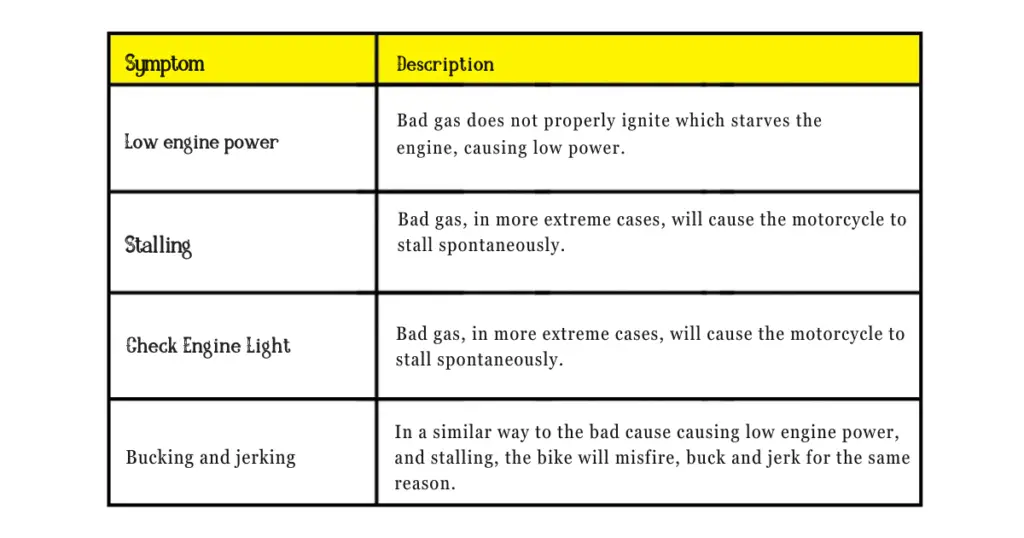Every motorcyclist looks forward to a thrilling ride, with the wind against their face and the open road stretching ahead. Yet, nothing puts a damper on this experience quite like a motorcycle that fails to deliver its best performance. A frequent villain behind such disappointments? Bad gas.
It’s not just an inconvenience; bad gas can impair your motorcycle’s performance and, in worst-case scenarios, lead to costly damages. In this guide, we will journey through the nuances of bad gas, starting with its definition, the alarming symptoms it presents, and finally, the strategies to counteract its ill effects. So what’re you waiting for? Let’s get to it!
So, What Is “Bad Gas” Anyway?
Before we dive into the symptoms and solutions of bad gas, it’s essential to understand what bad gas is. Gasoline is a volatile substance that can degrade over time. When left sitting in your motorcycle’s tank for an extended period, the gas can become stale or contaminated, leading to what is commonly referred to as “bad gas”.
How Long Does It Take For Gas To Go Bad In Motorcycles?
The timeframe for gas to go bad in a motorcycle can range from a few weeks to a couple of months. Several factors influence this, including the quality of the gas, the size of the gas tank, and the storage conditions. Ethanol-blended fuels are particularly prone to degradation and separation, which can hasten the process.
Bad Gas In Motorcycle Symptoms

Now, let’s get to the heart of the matter – the telltale signs of bad gas in a motorcycle. Here are some symptoms to watch out for:
Difficulty Starting
A motorcycle having trouble starting is one of the most common signs of bad gas. If your motorcycle is struggling to start or won’t start at all, the old or bad gas could be clogging up the fuel system.
Related: Motorcycle Wont Idle? Know This
Sputtering
Bad gas can cause your motorcycle to sputter or stutter, particularly when accelerating. This symptom is caused by the contaminated gas disrupting the smooth combustion process inside the engine.
Related: Why Is My Motorcycle Losing Power When Accelerating?
Smell of Raw Fuel
A strong or unusual odor of gasoline coming from the fuel tank or fuel system can be another symptom of bad gas. Stale or contaminated fuel can produce a rancid smell that differs from the typical odor of fresh gasoline.
Other Potential Symptoms
Other potential symptoms of bad gas include decreased fuel efficiency, black or white smoke coming from the exhaust pipe, and decreased engine power. In severe cases, bad gas can even cause damage to your motorcycle’s engine, leading to costly repair.
Now, here’s a video detailing how to assess exactly how bad the gas really is:
How To Fix Bad Gas In A Motorcycle?
If you’ve identified the symptoms of bad gas in your motorcycle, it’s crucial to take immediate action to prevent further damage. Here are some steps you can take:
Use A Fuel Stabilizer (mild cases)
For mild cases where the gas is just beginning to go bad, using a fuel stabilizer can help rejuvenate the gas and prevent further degradation. Fuel stabilizers work by bonding with the gasoline to create a stable fuel mixture, prolonging the fuel’s lifespan.
Drain The Tank (mild cases)
If the fuel stabilizer doesn’t resolve the issue, the next step would be to drain the tank. This involves disconnecting the fuel line and draining the old gas into a safe container. Remember, improper disposal of gasoline can be hazardous to the environment.
Drain The Tank and Clean It (worst case)
For severe cases where the gas has gone entirely bad, not only should you drain the tank, but clean it thoroughly. This step involves removing the tank from the motorcycle, emptying it, and cleaning it out with a fuel tank cleaner. It’s also advisable to clean out the fuel lines and replace the fuel filter to ensure no residues are left behind.
Like I said, this is worst case scenario, but when draining the tank, every bike is different so it’s not a one-step-fix-all kind of situation. Still, here’s a video detailing the general steps to do so:
Read next:
> How Often Should You Change Your Oil On A Motorcycle?
> How To Check Oil Level On A Motorcycle
Recap of Main Points
Bad gas in a motorcycle can cause a host of problems, from difficulty starting to decreased fuel efficiency. The best way to prevent bad gas is through regular maintenance and proper storage of your motorcycle. However, if you do encounter bad gas, using a fuel stabilizer, draining the tank, or even cleaning the tank and fuel system can help resolve the issue.
Stay vigilant for these symptoms to ensure your motorcycle stays in top condition. And remember, as with anything, prevention is always better than cure, so keep up with your motorcycle’s regular maintenance to avoid issues like bad gas in the future.
Read next: Motorcycle Goes Into Gear But Wont Move? Do This